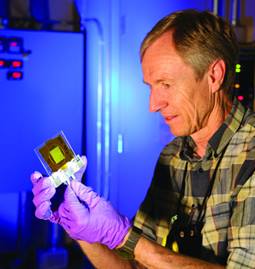A Production Breakthrough . . . and a Priceless Benefit
Los Alamos National Laboratory: Robb Kramer
Los Alamos scientist Meiring Nortier holds a thorium foil test target for the proof-of-concept production experiments. Research indicates that it will be possible to match current annual, worldwide production of Ac-225 in just two to five days of operations using the accelerator at Los Alamos and analogous facilities at Brookhaven.
What if you could do a year’s worth of work in a week? You would probably be healthier and perhaps a lot happier, to say nothing of much more productive.
In a real sense, that’s what a collaboration of researchers at Los Alamos and Brookhaven National Laboratories recently figured out how to do, through support from the Office of Science’s Nuclear Physics program. And the benefits are expected to go far beyond the precious prospect of increased productivity to the priceless possibility of hope and healing.
Specifically, the researchers developed a new technique which will dramatically accelerate the production of an important medical isotope, actinium-225 (Ac-225). Ac-225 is a rare but highly-prized therapeutic isotope, since it has the ability to precisely destroy cancerous cells without damaging healthy surrounding tissue. It also has a short half-life, which means the radioactive actinium decays away after a very short time.
Ac-225 works by sending out alpha particles, which are a bit like grenades with extremely short fuses: They can cause a lot of damage quickly in confined spaces, but they’ve virtually no penetration power. One hit is about it.
Its combination of great power and little penetration makes Ac-225 a potentially potent weapon against cancers. However, production of the isotope has been costly and meager, too meager even to support clinical trials of medicines based on the isotope.
That changed earlier this spring when researchers discovered an economical technique that could match a year’s production of Ac-225 in less than a week. Developed at Los Alamos Lab’s Isotope Production Facility, the technique uses proton beams smashing into the metal thorium to speed production of the rare isotope. And yes, it is likely to produce the equivalent of a year’s supply within a week.
Increased supplies are likely to be essential since the current demand for Ac-225 far outstrips its supply by traditional methods of production. And its annual need could reach 100 times current demand within two years.
That’s because new medicines made with Ac-225 are likely to be especially effective at treating diffuse cancers, which have spread through healthy tissue instead of staying concentrated in a single tumor. Diffuse cancers are among the most difficult to treat, and in many cases are considered untreatable.
The potential to treat them with Ac-225 is there, if production methods can be scaled up. So teams of researchers supported by the DOE Office of Science’s Isotope Program at Los Alamos and Brookhaven have joined with others at Oak Ridge National Laboratory in order to do just that.
Perhaps someday soon, researchers will be turning out what used to be a year’s supply of Ac-225 in just a single week. That’ll make for vast new supplies of an important therapeutic. Even better, it’ll mark a new hope for cancer patients, and perhaps even a future.
The Department’s Office of Science is the single largest supporter of basic research in the physical sciences in the United States, and is working to address some of the most pressing challenges of our time. For more information please visit http://science.energy.gov. For more information about Los Alamos, Brookhaven, and Oak Ridge National Laboratories, please go to: http://www.lanl.gov/, http://www.bnl.gov, and http://www.ornl.gov, respectively. For more information about the DOE Office of Science Isotope Program, please go to http://www.isotopes.gov, and for video about this breakthrough, please go to http://www.youtube.com/watch?v=E0r0-FJqmpc&feature=youtu.be.
Charles Rousseaux is a Senior Writer in the Office of Science.


